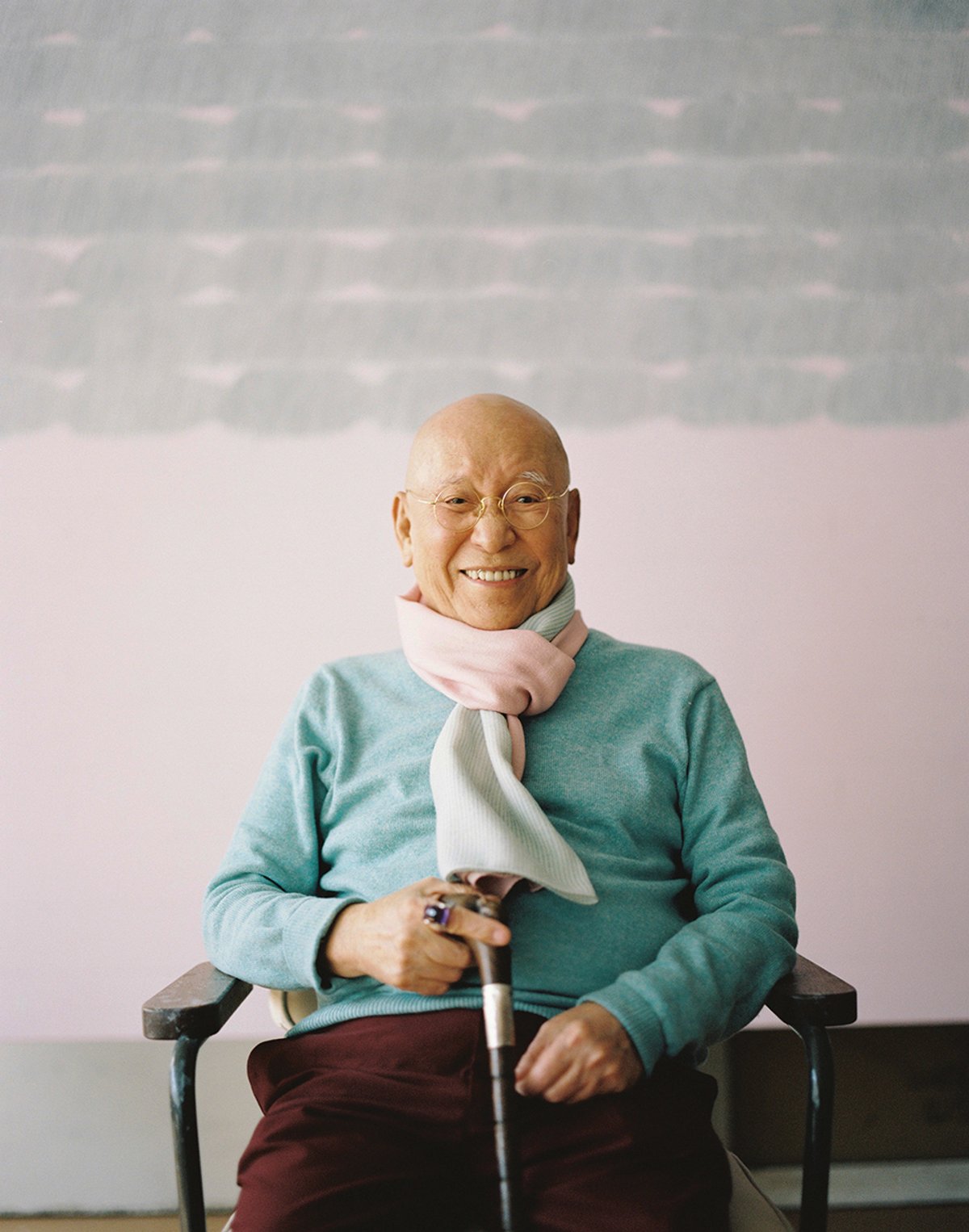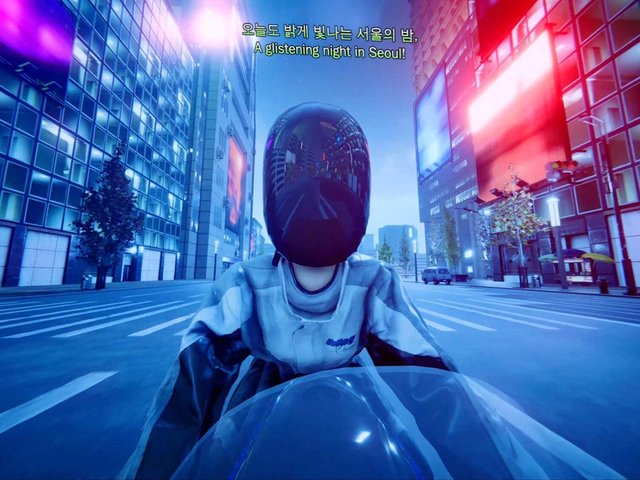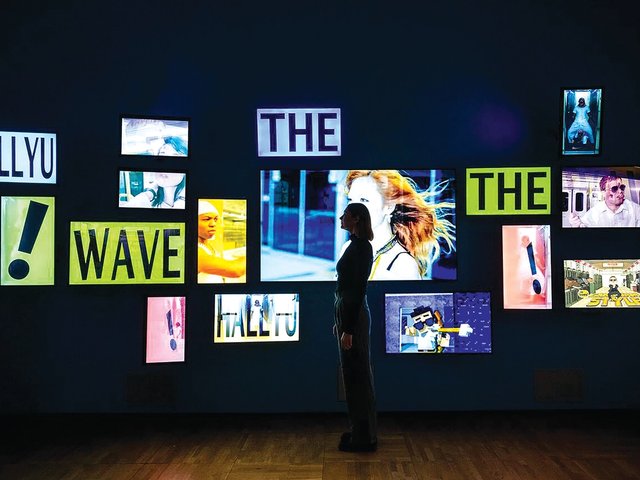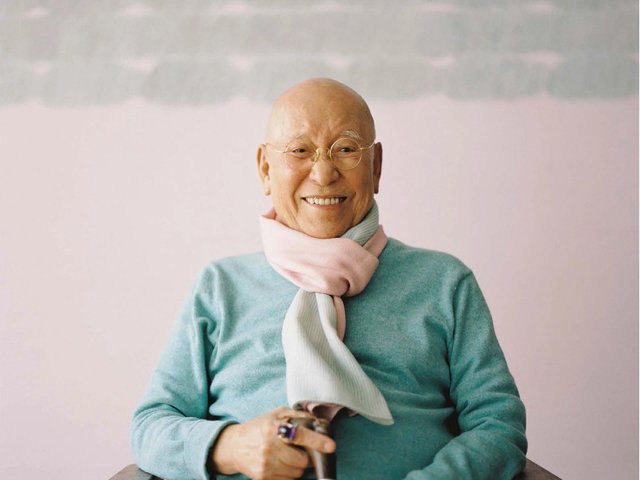Park Seo-Bo was a towering figure in Korean contemporary art, both as an artist and an educator. Known overseas as the “Father of Korean Contemporary Art”, he lived to see the Dansaekhwa (monochrome) movement, and his role in it, receive international recognition in the past decade. After revealing his lung cancer diagnosis in February, at the age of 91, he wrote, “I have lived enough, but there are still things I want to paint.”
Born Park Jaehong in 1931 in Yecheon, southern Korea, he later moved with his family to Gyeonggi Province, where his father worked as a judicial scrivener. Against his father’s wishes that he should study law, Park enrolled at Hongik University, Seoul, in 1950, to study Eastern painting. However, with the outbreak of the Korean War in June of that year, he was drafted to serve in the military, where his duties included map-making. On returning to academia in 1952, he had to transfer to Western painting because of a lack of teachers in his original department. In 1954, during his final year, Park made his artistic debut at the 3rd National Art Exhibition with two figurative paintings, Nude (A) and Sunflower.
On the eve of graduation, he fled and took on the name “Seo-Bo” to avoid detection
Park volunteered for officer training in 1954, trusting the government’s promise of draft exemption for those who completed the course, unless war resumed. However, the government broke its promise and arrested students during their graduation ceremony. On the eve of his graduation from Hongik University, Park fled and took on the name “Seo-Bo” to avoid detection. He grew a beard and wore a fedora to appear older, until he was part of a collective lawsuit in 1961 against the military authorities which enabled him to give up his disguise.
After completing his studies, Park joined Seoul’s Lee Bongsang Painting Institute in 1957 and became a member of the Anguk school, which advanced Korean abstract art through embracing an improvisatory Art Informel approach. Park began to explore bold, self-destructive methods. One day in 1958, he was working on a figurative painting of the Buddha’s face for the 3rd Contemporary Exhibition in Seoul. Growing disillusioned with the process, he defaced the artwork using a whetstone, threw paint and kicked the canvas before leaving the studio. On his return, he found that the altered canvas revealed the artistic direction he had been seeking.
At the institute, Park met Yoon Myung-Sook, a student from Hongik University. Yoon later reflected on their engagement: “On a drizzling day, we visited a quaint whisky bar in Jongno. It was my first whisky experience, and I got a little tipsy. Out of the blue, he proposed, and I accepted.” But the couple’s beginnings were anything but romantic. They wed in 1958, and during their honeymoon were joined by a police officer and artist friend, Kim Tschang-Yeul, who acted as a bodyguard for Park, then still in hiding, as the young artist couple spent the next few years moving from place to place.
Paris sojourn
In 1961, Park travelled to Paris to attend the Unesco exhibition Jeunes Peintres du Monde, and spent nearly 10 months in the city. While assisting the artist Lee Ungno, Park procured leftover wood and fabric scraps, pieced them together and painted the composite work black, naming it Péché Originel No. 8. This new approach paved the way for the series Primordialis, where Park incorporated techniques such as creating soot with ignited cotton, texturising the canvas with a wire brush and attaching threads. After his Paris sojourn, Park put on a solo exhibition, Primordialis, at the National Central Library Gallery, Seoul, in October 1962, and was told that his work resembled a war-scarred figure. Though the artist intended to depict “a form before the advent of some living substance”, he concurred that the final imagery indeed reflected the scars of war.
Inspired by watching his younger son practise Hangul, the official Korean script, tearing and scribbling on pages as he made mistakes, Park adopted a unique technique. Realising that “striving to fill the void signifies intent while yielding captures the beauty of resignation”, Park mirrored his son’s approach. He methodically applied white paint on a canvas with a ruler, drew a line with a pencil, and, before it set, concealed it with paint, then added another line. At a colleague’s suggestion, this series was later named Écriture, French for “writing”.
International collections
Park launched the Écriture series at a 1973 solo exhibition at Muramatsu Gallery, Tokyo, following the advice of a friend, Lee Ufan, who said, “If you are recognised in Japan first, you will be recognised in Korea.” The monochrome Écriture series with pencil, which Park worked on intensively until 1986, was later collected by New York’s Museum of Modern Art and Solomon R. Guggenheim Museum. Park continuously varied the Écriture series, pasting wet Korean paper on canvas in the 1980s, focusing on straight lines instead of zigzags in the 1990s, and adding the colours of nature to the canvas after being captivated by the autumn foliage of Tokyo, where he held a solo exhibition in 2000.
Beyond his work as an artist, Park profoundly influenced Korean contemporary art through his roles as an educator and administrator. Starting in 1962, he taught in the painting department at his alma mater, Hongik University. For more than three decades, until 1997, he was a cornerstone of Korean art education. As dean of the university’s College of Fine Arts, he modernised departments to meet contemporary needs. After being elected vice-chairman of the Korean Fine Arts Association in 1970, he organised the Indépendant exhibition, to select artists for international showcases. This initiative gave emerging artists such as Lee Kun-Yong and Shim Moon-Seup a unique opportunity to present their experimental pieces at the eighth Paris Biennale in 1973.
While Park’s efforts to enliven the Korean art scene sometimes faced criticism, his lasting impact on Korean contemporary art is undeniable. Ha Indoo, a friend who had a complex relationship with Park, viewed the 1980s as a period when, as he told Art in Culture magazine, “contemporary art became more homogenised, and collective thought gravitated towards factionalism”, challenging Park’s influence and opposing his re-election as president of the Korean Fine Arts Association. However, Park’s impact on the local art community has only grown. In 2019 a retrospective featuring 160 of his works was held across two galleries at the National Museum of Modern and Contemporary Art in Seoul.
Marketing clout
Despite Park’s prominence, the market only recently acknowledged the Dansaekhwa movement and Park’s role in it. In 2012, the National Museum of Modern and Contemporary Art officially introduced Korean monochrome painting with the exhibition Dansaekhwa: Korean Monochrome Painting. Galleries such as Perrotin and Kukje subsequently showcased Dansaekhwa artists, and the 2015 exhibition Dansaekhwa at Palazzo Contarini Polignac during the Venice Biennale amplified global interest. A significant milestone was Park’s 2016 exhibition at London’s White Cube. “The paintings started selling after the White Cube,” Park observed, and in his 80s he found his art was in high demand. This year his 1975 piece Écriture No. 37-75-76 fetched a record $2.6m at Sotheby’s in Hong Kong.
In recent years, Park established the Park Seo-Bo Foundation (formerly Gizi Foundation), inaugurated a museum dedicated to his works on Jeju Island, South Korea, and funded scholarships at Hongik University. Yet, his endeavours highlight the inescapable political nuances of Korean society. In 2022, he pledged $1m to the Gwangju Biennale, launching the Park Seo-Bo Art Prize for emerging artists. The inaugural winner, the Korean artist Oum Jeongsoon, expressed gratitude for the recognition. But just a month after the award ceremony, the prize was abolished because of controversies surrounding Park’s involvement with pro-government art organisations during the Gwangju Uprising in 1980. Regarding these disputes, Park commented: “Without backlash, there’s no progress. But we need to have contemporary arguments for 2023. The zeitgeist is alive and changes rapidly.”
In late August, Park’s final exhibition was held at Johyun Gallery in Busan, South Korea, with Park and his grandson present. A solo exhibition at New York’s White Cube is planned for November 2024. Lee Yoojin, director of the Park Seo-Bo Foundation, elaborated to The Art Newspaper on Park’s latest Écriture, which will be shown at White Cube: “Begun in 2022, this method involves pencil drawing over paint on old newspapers, eliminating text and images that depicted a world evolving into a psychiatric ward. While the repetitive drawing echoes the past Écriture’s philosophy of clearing one’s mind and heart, the intentional act of erasing for purification introduces a novel approach.” Piles of old newspapers and canvases stacked in the studio stand as a silent tribute to Park, who, until his last moments, ceaselessly honed his craft.
• Park Jaehong (Park Seo-Bo), born Yecheon County, Korea 15 November 1931; married 1958 Yoon Myeong-Sook (two sons, one daughter); died Seoul 14 October 2023






